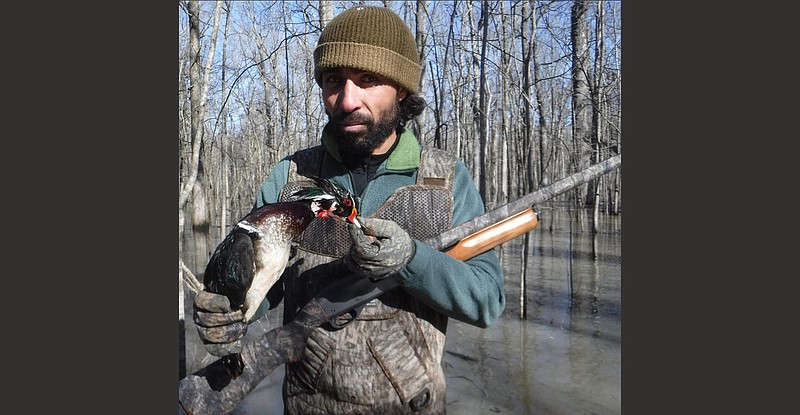Almost a full month of duck season remains in Arkansas, and if you haven't experienced duck hunting, now is the perfect time.
One of the biggest barriers for new hunters is finding a place to go, but that's not an issue in Arkansas. We have plenty of public duck hunting land in nearly every part of the state. That includes Northwest Arkansas, where there is some surprisingly good duck hunting on Beaver Lake. A full list of wildlife management areas, complete with maps and descriptions, is available on the Arkansas Game and Fish Commission website at www.agfc.com.
Before hunting, you need to get legal. If you were born after Jan. 1, 1969, you need to pass an approved hunter education course. You can take it online at www.huntered.com/arkansas. The online course costs $19.95, but it is the only option currently available due to coronavirus crowd limitations. You must be at least 10 years old to take the course.
After getting hunter education certified, Arkansas residents need a resident hunting license. You can buy the basic conservation license ($10.50) or the sportsman's license ($25), which entitles the holder to kill a full limit of ducks and also to hunt wild turkeys. You will also need a resident duck stamp ($7) and a federal duck stamp ($25). Your total license expense will be $42.50-$67.50.
Next, you will need a shotgun. It need not be fancy or expensive. You can buy a single-shot break-action model in 12- or 20-gauge for less than $100, or you can buy an inexpensive pump gun from $300-$600. If you are committed, you can spend as much as you want on a semi-automatic or an over/under.
When hunting migratory birds, a shotgun must not be capable of holding more than two shells in the magazine. If you can fit a third shell in the magazine, you must install a plug. You can buy a plug or make one. A double-barrel shotgun eliminates all doubt. Pumps and semi-automatics hold a shell in the chamber, giving a hunter up to three shots before having to reload.
For hunting waterfowl, you must use federally approved nontoxic shot. Steel shot is the most common and least expensive, and it works very well up to about 30-35 yards. A box of 25 cartridges costs about $12 for Remington Sportsman or Federal blue box. Premium brands can cost about $1 per shell. You can also use nontoxic steel alternatives such as tungsten, tungsten-iron, bismuth or Hevi-Shot. All of them outperform steel at longer distances.
Assuming you're going to hunt flooded timber on a public area, you will also need a pair of waders. Neoprene construction is best with heavily insulted boots. For Arkansas, wader boots should have at least 750 grains of Thinsulate insulation. Prices range widely. Beginners should start with an inexpensive pair and upgrade according to need.
Though not necessary, decoys can help lure ducks into a woodland opening, or hole. A light packer, I've hunted for many years with six decoys that I carry in a backpack. This allows me to get deep in the woods with relative ease, unburdened by a massive Santa Claus sack loaded with dozens of decoys.
Finally, you need a duck call. It needn't be expensive. You can buy them at any sporting goods store. Plenty of YouTube videos will show you how to blow a duck call. This isn't difficult. You need only to master a mallard's primary vocalizations. I primarily use a feed chuckle and a comeback call, and I use them sparingly. I also use a wood duck call. It is a reassurance call that can seal the deal on ducks that are reluctant to commit. You will encounter a lot of reluctant ducks on public areas in Arkansas. They have been blown at all the way down the Mississippi Flyway. They're looking for a safe place in the woods to land. Call just enough to draw their attention to the decoys. Stay still, stand tight against a tree for concealment and let silence be your friend.
Note the wind direction and find a spot with the wind in your face. Ducks like to land with the wind, and the hole should be open in front of you.
Speaking of concealment, camouflage is important in duck hunting. A winter woodland pattern is sufficient to blend into gray woods. Mainly you just want to break up your silhouette. Wear a facemask because a face peering skyward is very distinctive to sharp-eyed birds looking for danger.
It's fun to shoot ducks on the wing, but the mark of a good duck hunter is the ability to land ducks on the water. All it takes is one or two landers to bring in an entire flock. That's when you make your move. Shoot them on the rise, and try to shoot only male ducks, or drakes. They're the ones with the green heads.
If you're afoot, there are two good ways to find a place to hunt. One is to enter the woods at the legal entry time and simply outdistance other hunters. Another is to delay your entry and listen for shooting. That tells you where other hunters are and enables you to look for a place away from them. Resist the urge to encroach on other hunters. Yes, it is a public area, but hunters need a certain amount of space to work ducks.
Flooded woods can be intimidating for newcomers. There are no distinctive landmarks, and it is easy to get turned around. Take a GPS reading at your vehicle or at your entry point into the woods. Mark your hunting spot and also a few waypoints between your terminus and entry. Also take compass readings. Resist the urge to distrust your compass. No matter how different the woods look on your way back out, your compass is not lying.
Enjoy yourself. Be courteous. Be safe.
